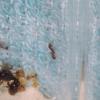I'm including a link with the pictures I took: https://imgur.com/gallery/BQOxhJh
If anyone has any information, I'd greatly appreciate it. Thanks in advance.

What you found was probably a satellite colony, an interesting behavior where carpenter ants congregate in an area away from the main nest to rest or collectively hide.
Leave the Road, take the Trails - Pythagoras
Utah Ant Keeping --- Here
DIY Formicariums and Outworlds --- Here
Honeypot Ant Journal --- Here
Photo Album --- Here
Videos --- Here
3 of them are approximately 14 to 15mm long. The others are between 8 and 10mm. The larger ones look like the queen pictures I found, and the smaller ones look like normal workers.
Majors and queens have their differences but I can see why you made this mistake. When looking for a queen, her mid-section should be fairly large and have some distinct marks on the sides where her wings used to be. This does not apply to all species, but for most easier to find ants, this should be the case. If you use this method and still can't tell a queen apart, you can also look for 3 small spots on top of the ants head, similar to a crown. Again, not all species follow this, as some more primitive ants' workers have these simple eyes as well. My best advice, try not to use google images and ask around here instead. Hope this helps.
Hey everyone. Just a quick question here, because I'm highly confused. So today I was out ant hunting, looking for queens. And while looking, I turned over a large oak leaf on the ground and I found approximately 20 Camponotus novaeboracensis ants under it. At first they just sat there. But the moment I went to pick them up to put them in a test tube, they scurried, fast. I got about 7 of them into the tube. 3 of them are approximately 14 to 15mm long. The others are between 8 and 10mm. The larger ones look like the queen pictures I found, and the smaller ones look like normal workers. But, when I looked around, and I looked for over an hour up to 30 feet in diameter from where I found the ground, there were no nests. No eggs. No other carpenters. They have a black head, red body, and black gaster with thin hair and goldish rings. So that's why I say I think it's Camponotus novaeboracensis. But, when I put them in the tube, the larger 3 started to groom the smaller ones, and they all just kinda chilled. Didn't try running. Didn't try to tare the cotton away. They just chilled. It's it possible that this was a few different queens all huddled together under the leaf? I have never seen a bunch of ants huddled under anywhere before without having a queen and eggs/pupae nearby. And I searched. Looked everywhere. Even tore apart a few pieces of decaying wood that was nearby. Simply because I do not want to take a queen away from her colony, and don't want to take workers away from a queen. But finding absolutely nothing, I took the ones I was able to catch home to take some pictures of them. Does anyone know if this is common behavior for these or other carpenter ant species? And if it's not, what could be the reason that 20 or so ants were huddled together, with no colony or nest anywhere even remotely close? Cause I am highly confused.
I'm including a link with the pictures I took: https://imgur.com/gallery/BQOxhJh
If anyone has any information, I'd greatly appreciate it. Thanks in advance.
If you're from the colder half of the U.S. then they were probably hibernating or just beginning to wake up from hibernation.
0 members, 1 guests, 0 anonymous users